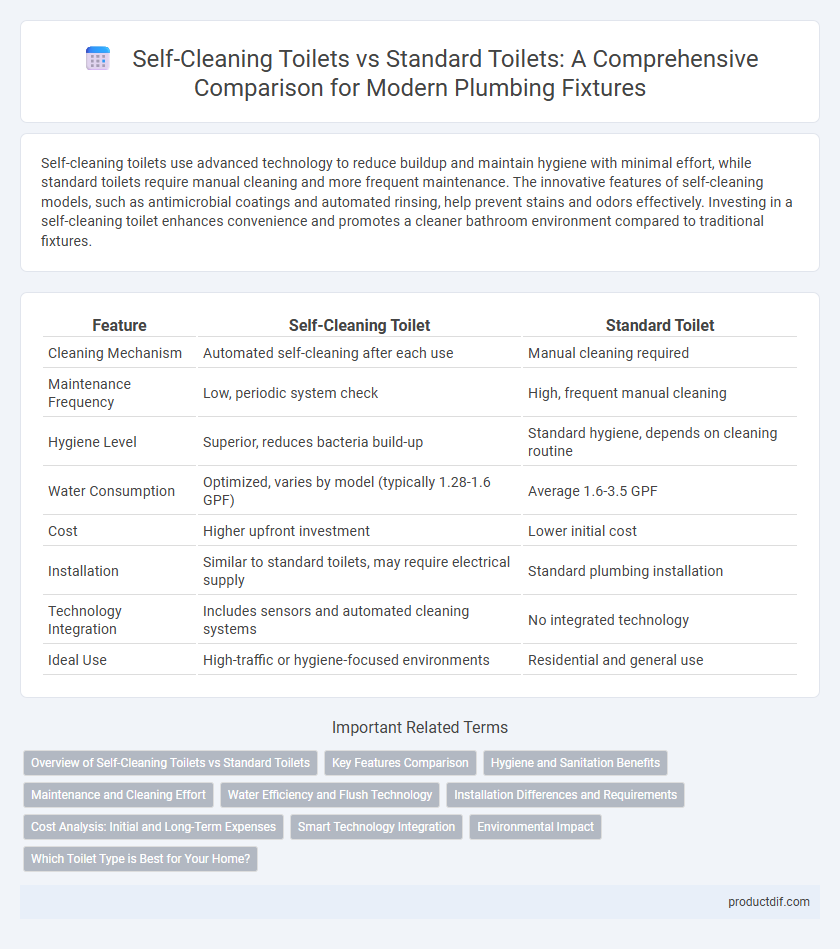Self-cleaning toilets use advanced technology to reduce buildup and maintain hygiene with minimal effort, while standard toilets require manual cleaning and more frequent maintenance. The innovative features of self-cleaning models, such as antimicrobial coatings and automated rinsing, help prevent stains and odors effectively. Investing in a self-cleaning toilet enhances convenience and promotes a cleaner bathroom environment compared to traditional fixtures.
Table of Comparison
| Feature | Self-Cleaning Toilet | Standard Toilet |
|---|---|---|
| Cleaning Mechanism | Automated self-cleaning after each use | Manual cleaning required |
| Maintenance Frequency | Low, periodic system check | High, frequent manual cleaning |
| Hygiene Level | Superior, reduces bacteria build-up | Standard hygiene, depends on cleaning routine |
| Water Consumption | Optimized, varies by model (typically 1.28-1.6 GPF) | Average 1.6-3.5 GPF |
| Cost | Higher upfront investment | Lower initial cost |
| Installation | Similar to standard toilets, may require electrical supply | Standard plumbing installation |
| Technology Integration | Includes sensors and automated cleaning systems | No integrated technology |
| Ideal Use | High-traffic or hygiene-focused environments | Residential and general use |
Overview of Self-Cleaning Toilets vs Standard Toilets
Self-cleaning toilets feature advanced technologies such as UV light, electrolyzed water, or automated cleaning cycles that reduce bacterial buildup and minimize manual maintenance. Standard toilets rely on manual cleaning and basic flushing mechanisms, which often require regular scrubbing to maintain hygiene. The self-cleaning models provide enhanced sanitation and convenience, making them a cost-efficient upgrade in both residential and commercial plumbing fixtures.
Key Features Comparison
Self-cleaning toilets integrate advanced technologies like UV light sanitation and automated rim sprays to reduce bacterial buildup, while standard toilets rely purely on manual cleaning. The self-cleaning models often feature touchless flushing and antimicrobial coatings, enhancing hygiene and user convenience. Standard toilets typically offer straightforward operation with lower initial costs but require frequent maintenance to prevent odors and stains.
Hygiene and Sanitation Benefits
Self-cleaning toilets use advanced technologies such as UV light, electrolysis, or automated rinsing to reduce bacterial buildup and minimize the need for manual cleaning, significantly enhancing hygiene compared to standard toilets. Standard toilets rely heavily on frequent manual cleaning and chemical disinfectants, which may leave residual germs and require more maintenance. The automated sanitation features in self-cleaning toilets help prevent odors, reduce cross-contamination, and promote a consistently cleaner bathroom environment.
Maintenance and Cleaning Effort
Self-cleaning toilets significantly reduce maintenance and cleaning effort by using automated cleaning cycles, antimicrobial coatings, and advanced flushing technologies that minimize residue buildup and bacterial growth. Standard toilets require frequent manual cleaning with brushes and harsh chemicals to prevent stains and odor, leading to increased labor and ongoing maintenance costs. The investment in a self-cleaning toilet enhances hygiene and long-term convenience, offering a more efficient solution for households and commercial facilities.
Water Efficiency and Flush Technology
Self-cleaning toilets incorporate advanced flush technology that optimizes water efficiency by using targeted high-pressure jets and sensor-activated flush cycles, significantly reducing water consumption compared to standard toilets. Standard toilets typically rely on gravity-fed flush systems with fixed water volumes, often consuming between 1.6 to 3.5 gallons per flush, whereas self-cleaning models utilize dual-flush or vacuum-assisted flush mechanisms to minimize water waste. These innovations in self-cleaning toilets not only enhance hygiene and maintenance but also contribute to substantial water savings, supporting sustainable plumbing fixture practices.
Installation Differences and Requirements
Self-cleaning toilets require more complex installation compared to standard toilets due to integrated electronic components and water purification systems. These fixtures often need dedicated electrical outlets and reinforced water connections to support additional features like bidet functions and UV sterilization. Standard toilets typically involve straightforward plumbing and do not require electrical wiring, making installation quicker and less costly.
Cost Analysis: Initial and Long-Term Expenses
Self-cleaning toilets typically have higher initial costs, ranging from $800 to $2,000, compared to standard toilets that average between $100 and $300. Long-term expenses for self-cleaning models may decrease due to reduced maintenance and cleaning products, whereas standard toilets often incur ongoing costs for manual cleaning supplies and labor. Energy consumption for self-cleaning toilets can add to utility bills, but potential water savings from advanced flushing technology might offset these expenses over time.
Smart Technology Integration
Self-cleaning toilets leverage advanced smart technology integration, featuring sensors that detect usage and automatically activate cleaning cycles with UV light or electrolyzed water, enhancing hygiene and reducing manual maintenance. Standard toilets lack these automated functions, requiring manual cleaning and regular maintenance to prevent odors and bacterial buildup. The incorporation of IoT technology in self-cleaning toilets also allows remote monitoring and maintenance alerts, promoting efficiency and sustainability in modern bathroom fixtures.
Environmental Impact
Self-cleaning toilets significantly reduce water consumption by using advanced flushing technologies that optimize each flush, unlike standard toilets that often waste gallons per use. These fixtures minimize the need for harsh chemical cleaners, thereby lessening harmful runoff and contributing to improved water quality. By lowering water use and chemical reliance, self-cleaning toilets offer a more sustainable solution compared to traditional plumbing fixtures.
Which Toilet Type is Best for Your Home?
Self-cleaning toilets utilize advanced technologies such as UV light and electrolyzed water to reduce bacterial buildup and minimize manual cleaning, making them ideal for busy households seeking hygiene and convenience. Standard toilets remain popular for their affordability and straightforward maintenance, fitting well in budget-conscious homes without needing extra features. Choosing the best toilet type depends on balancing initial costs, maintenance preferences, and desired sanitary benefits for your home environment.
Self-Cleaning Toilet vs Standard Toilet Infographic

 productdif.com
productdif.com